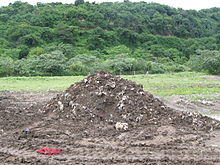Sludge

Sludge is a semi-solid slurry that can be produced from a range of industrial processes, from water treatment, wastewater treatment or on-site sanitation systems. It can be produced as a settled suspension obtained from conventional drinking water treatment,[1] as sewage sludge from wastewater treatment processes[2]: 23–25 or as fecal sludge from pit latrines and septic tanks. The term is also sometimes used as a generic term for solids separated from suspension in a liquid; this soupy material usually contains significant quantities of interstitial water (between the solid particles). Sludge can consist of a variety of particles, such as animal manure.[3][not specific enough to verify]
Industrial wastewater treatment plants produce solids that are also referred to as sludge. This can be generated from biological or physical-chemical processes.
In the activated sludge process for wastewater treatment, the terms "waste activated sludge" and "return activated sludge" are used.
In food processing and beverage-making industries, sludge can have a high protein content and can contain other nutrients that can be used for beneficial purposes such as processing for animal feed; this avoids having to dispose of the sludge at a landfill.
References
- ISBN 978-0-07-163011-5.
- ISBN 9780071122504.
- ^ Byfield, Mike (July 7, 1997). "Farmers line up for their slug of pulp sludge". Alberta Newsprint Co.
